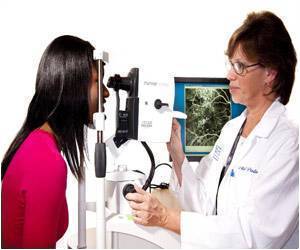High-contrast visual stimulation can help damaged retinal neurons regrow optic nerve, revealed a study in mice funded by the National Institutes of Health (NIH).

‘High-contrast visual stimulation can help damaged retinal neurons regrow optic nerve fibers, otherwise known as retinal ganglion cell axons.’





In combination with chemically induced neural stimulation, axons grew further than in strategies tried previously. Treated mice partially regained visual function. The study also demonstrates that adult regenerated central nervous system (CNS) axons are capable of navigating to correct targets in the brain. The research was funded through the National Eye Institute (NEI), a part of NIH. NEI Director Paul A. Sieving said, "This research shows that mammals have a greater capacity for central nervous system regeneration than previously known."
The researchers induced optic nerve damage in mice using forceps to crush the optic nerve of one eye just behind the eyeball. The mice were then placed in a chamber several hours a day for three weeks where they viewed high-contrast images-essentially changing patterns of black lines. The mice had modest but significant axonal regrowth compared to control mice that did not receive the high-contrast visual stimulation.
Prior work by the scientists showed that increasing activity of protein called mTOR promoted optic nerve regeneration. And so they wondered if combining visual stimulation with increased mTOR activity might have a synergistic effect. Two weeks prior to nerve crush, the scientists used gene therapy to cause the retinal ganglion cells to overexpress mTOR. Optic nerve crush was performed and mice were exposed to high-contrast visual stimulation daily. After three weeks, the scientists saw more extensive regeneration, with axons growing through the optic nerve as far as the optic chiasm, a distance from the eye of about six millimeters.
Encouraged by these results, the researchers again increased mTOR activity but then forced mice to use the treated eye during visual stimulation by suturing shut the good eye. This combined approach of increasing mTOR activity with intense visual stimulation promoted regeneration down the full length of the optic nerve and into various visual centers of the brain.
Advertisement
The regenerating axons also navigated to the correct brain regions, a finding that Huberman said sheds light on a pivotal question in regenerative medicine, "If a nerve cell can regenerate, does it wander or does it recapitulate its developmental program and find its way back to the correct brain areas?"
Advertisement
Visual function was partially restored in animals that received visual/mTOR combination therapy. The investigators used four tests to assess four types of visual perception: ability to track moving objects, pupillary reflex, depth perception, and ability to detect an overhead predator-a stimulus that normally causes mice to freeze or flee for cover. Mice treated with combination therapy performed significantly better than untreated mice in two of the four tests.
"This study's striking finding that activity promotes nerve regrowth holds great promise for therapies aimed at degenerative retinal diseases," noted Thomas Greenwell, NEI program director for retinal neuroscience research. Greenwell said the research has great relevance to the NEI Audacious Goals Initiative (AGI), a sustained effort to develop regenerative medicine for retinal diseases.
For future therapies that preserve optic nerve axons, Huberman envisions the development of filters for virtual reality video games, television programs, or eyeglasses designed to deliver regeneration-inducing visual stimulation. A drawback of the optic nerve crush model is that it does not mimic typical blinding diseases or injuries. The investigators are therefore currently examining the effect of intense visual stimulation in a mouse glaucoma model. Going forward, they are homing in on the specific qualities of visual stimulation that drive retinal regeneration.
Source-Newswise















